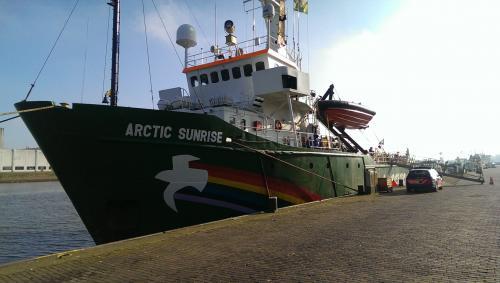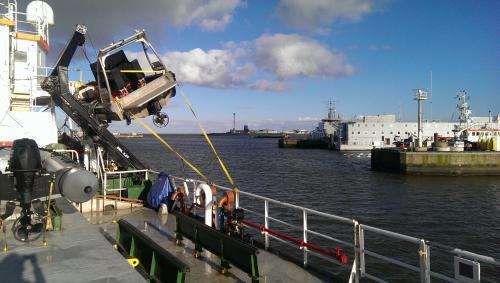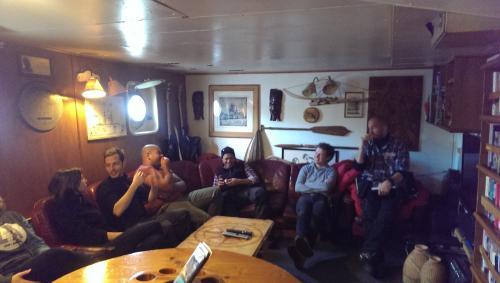I’m just back from an activist training and generally awesome experience on the Greenpeace ship, the Arctic Sunrise. We sailed in the North Sea from February 15 – 17.
What I learned aboard the Arctic Sunrise:

There’s too much about ships and people to adequately summarize everything I learned over the last few days. Therefore, I’ll make 3 brief statements and a commitment to work towards resolutions.
- Being an adrenaline junky can be socially useful, and I should be using my lack of fear to help make the world a better place.
- There seems to be a lack of transparency and communication inside of Greenpeace. Paired with perceived egos, possible power struggles and what seems to be a misunderstanding about the difference between “leadership” and “management”, this lack of transparency has eroded the trust of staff.
- Greenpeace has a unique resource that isn’t being utilized, we can change that.
Ships Log 15.02.16
We left port at 15:00 after several hours of safety training and an initial tour. During the first two hours at sea, we had fire drills involving assembly at the Muster Station, life jacket preparedness and some time in full immersion suits – suits that would allow you to survive extremely cold temperatures in the water, should you have to take a dive into the North Sea.

Soon after going below deck to learn about the roles and responsibilities of the ship’s crew, those without their sea legs began to fall ill. The North Sea wasn’t especially treacherous, but the Arctic Sunrise is also nicknamed “the Washing Machine”. Small swells toss the ship. As I felt my own sea sickness coming on, I did as advised and went above deck to stare at the horizon. We’d been at sea for three hours. Land had already faded, the sun was setting and I was clutching a cold railing and locking my eyes on the curve of the Earth. I breathed deeply and mostly ignored the few conversationalists who came and went, clutching buckets and trying to adjust to the pitching of the boat.
Eventually, the coldness forced me inside and a mere walk down the stairs, through the hull and into the belly of the ship sent me reeling. I soon discovered that 70% of my comrades were clutching buckets and kneeling before toilets. I assumed a fetal position, clutching the last available bucket, and leaned my head against the cool pleather sofa back in the Ship Bar. I remained in this position for well over an hour, intent on using my mind to establish my equilibrium.

The medic, Cat, came around forcing everyone to take seasickness pills. The pills take six hours to work, so the act of taking them was more as a placebo to try and convince the mind that all is well. One of our less affected colleagues brought around a small bowl of white rice. Having skipped dinner, I nibbled on the rice, sharing a single bowl with my counterpart on the sofa – Vally was in the same position, ill, but not vomiting, eyes closed but not sleeping.
I started to feel a little better, trusting myself to move. However with 70% of the trainees partially or fully incapacitated, the Captain decided to turn the ship around and go to anchorage along the coast of Texel, an island off the coast of the Netherlands. We dropped anchor for the night.
Ships Log 16.02.16
The next day I awoke unable to speak. The dry, cold air in my cabin paired with the uneasiness my body was feeling had taken a toll on my vocal cords. Revely came at half past seven, and we gathered in the Mess Hall for a bit of breakfast before the morning chores. The sea was calm, and the general atmosphere anticipatory for the days events. During breakfast, I was disappointed to learn that we would not be returning to the open sea, as sea sickness would likely make the training activities impossible. The trainers and the Captain had decided to remain at anchor.

We all participated in the typical morning chores. I dug through some trash and separated recyclables. When the chores were finished, we broke into small groups for more detailed tours and explanations of the ship. Four groups rotated through the Deck, the Engine Room, the Radio Room and the Bridge. My group started with the Deck, which included not only the outside deck, but the Poop Deck and the Storage Deck. We learned about RHIB (rigid haul inflatable boats, the ones you know from Greenpeace photos) launching and docking procedures. We saw the ROV camera, which can be dropped into the ocean and take pictures of the ocean floor. We saw the locked lockers contained thousands of euros worth of Polar equipment and learned a little about the ships sewage system.
Next was the engine room, where we saw the tools and materials the crew had on board. Benches and chairs in the ships haul were self made, and the crew proudly talked about some of the crazy shit they’d constructed for various onboard campaigns. Iain, the 2nd Engineer, explained the engine’s pieces and parts to us, but I was pretty out of my depth. Still, shimming down the engine shaft and learning that we could steal the boat from under the decks was pretty interesting. The last two tours, the Radio Room and the Bridge, were full of interesting information on communication and navigation instruments. I won’t get too detailed, suffice to say I’m now pretty interested in nautical equipment and navigational techniques. Also, even with a calm sea, the crows nest sways quite a bit.

After lunch, we met in the hull to practice climbing the specialized ladders Greenpeace activists use to scale the sides of ships and oil rigs. Then we all put on boat suits and rubber boots and headed to the deck as the crew started to lower the two RHIBs we’d be using into the cold sea. We drove the ribs around and around the Arctic Sunrise for several hours. Everyone had a chance to drive both boats before we began to climb the ship. The practice in the hull was easy – we were wearing street clothes and shoes. On the side of the ship, where falling means you plug into the icy water, the boat suits and rubber boots felt excessive. Climbing was hard, really hard, especially with the crew spraying us with a water canon. They laughed and yelled at us to get off their ship, mimicking the typical scenario Greenpeace climbers find themselves in. I reached the top, but struggled to pull myself over the rail. I was soaked through three layers of clothing, I couldn’t feel my feet or my hands, and the last pull up was nearly impossible. After hanging for several minutes, I looked up at the crew, smiled and asked “Could you pull me up now?” I probably could have hung there for a while longer, but I was too cold and too exhausted to struggle.
Once everyone was on board and the RHIBs back on deck, we hurried to our cabins to change and then to the Mess Hall to make warm cups of tea. We gathered in the lounge and received our assignment – come up with an idea that the Ships Unit can steal. Utilize the crews expertise and knowledge to judge viability. We’d be sharing our ideas after morning chores on the third day.
If you’re a regular reader, you know I love having ideas. I quickly left the lounge to ask Iain if my idea to strand the Arctic Sunrise on a beach was viable. It was, but my group and I didn’t have enough time to wrap the striking image of one of the Greenpeace ships out of water with an inspiring action and campaign message. The crew liked the idea enough to spin it for hours, while we drank beers and I made a presentation on our backup idea.

I went to bed early, around 10pm because I was scheduled to have Watch from 4am to 8am. I was feeling pretty broken when my head hit the pillow, my head was pounding and I had a fever. At 4am when the Chief Mate knocked on my cabin door, I silently slipped out of the upper bunk (so as not to awake my roomie) and grabbed a coffee before heading to the bridge. Once there, my partner, Lilian, the Chief ate and I kept watch. Lilian and I did rounds on the ship, checking for fires, water, anything out of the ordinary. As the sun rose, only the three of us were awake to see, and I started to feel that feeling I get whenever an amazing experience is coming to an end – the desire to ensure that the memories are cemented, and I return to visit the Arctic Sunrise again soon.